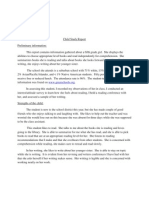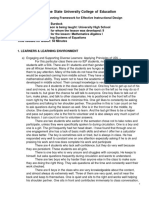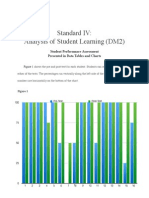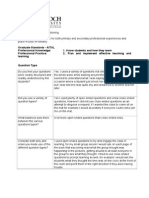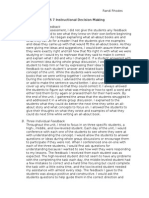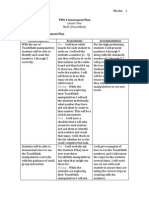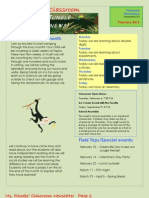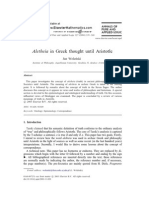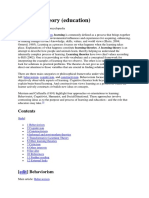Eced461 tws6 Rhodes
Eced461 tws6 Rhodes
Uploaded by
api-200991021Copyright:
Available Formats
Eced461 tws6 Rhodes
Eced461 tws6 Rhodes
Uploaded by
api-200991021Original Title
Copyright
Available Formats
Share this document
Did you find this document useful?
Is this content inappropriate?
Copyright:
Available Formats
Eced461 tws6 Rhodes
Eced461 tws6 Rhodes
Uploaded by
api-200991021Copyright:
Available Formats
ECED 461
Randi Rhodes
TWS 6 Analysis of Student Learning Unit
A. Whole Class
Pre-Assessment Table
Student
1
Middle
2
3
4
5
6
7
8
9
10
11
Low
12
13
14
15
16
17
18
19
20
21
High
22
23
24
Did they
stick to
topic?
Did they have
pictures/senten
ces
Did
pic./sent.
relate?
Is it
teaching all
about
_____?
Yes (how-to)
Yes
Yes
No
Yes
Yes (how-to)
Yes (how-to)
No
Yes
No
Yes
Yes
Yes (1)
Yes
Yes
No
Yes
No
Yes (1)
Yes
Yes
Yes
Yes
No
Yes
No
Yes
Yes
No
No
No
No
Yes
No
No
No
No
Yes (1)
No
No
No
Yes (how-to)
No
Yes
Yes
Yes
Yes
No
Yes
No (1 pic)
Yes
Yes (1)
Yes
Yes
No
Yes
No
Yes
Yes
Yes
Yes
No
No
No
No
No
Yes
Yes
Yes
Yes (1)
Yes
No
No
No
Yes (1)
No (2 pic)
Yes
No
No
No
The majority of the class did not know how to complete an all-about
book correctly. Sixty-five percent of the class knew how to pick a topic and
write only about that topic and out of that sixty-five percent, four students
picked topics based on how they should write a how-to story, which was
their last unit of writing. Eighty percent of the students wrote sentences
and drew pictures for their books, which is expected because they have
been working on the writing process for several months. The number in
ECED 461
Randi Rhodes
parenthesis is the number of sentences they wrote throughout the whole
book, and if it has pic behind it that is the number of pictures they drew.
Seventy percent of the class could draw pictures to correspond with their
sentences. Again, this is something that the students have been working
on for the past several months, regardless of the specific unit of writing.
Only fifteen percent of the students taught me something through their
writing. This category judged whether they picked an appropriate topic
and if they told me facts about their topic in their book. I did not expect
many students to do well in this category because this is the main
concept that is being taught in the all-about book unit.
Post-Assessment Table
Student
Did they
stick to
topic?
Did they have
pictures/senten
ces
Did
pic./sent.
relate?
Is it
teaching all
about
_____?
1
Middle
Yes
Yes
Yes
Yes
Yes
Yes
Yes
3
4
5
6
7
8
9
10
11
Low
12
13
14
15
16
17
18
19
20
21
High
22
23
Yes
Yes
Yes
Yes
Yes
No
Yes
Yes
Yes (Sent. not
developed)
Yes
Yes
Yes
No
Yes
No (2 pics.)
Yes
Yes
Yes
No
Yes
Yes
Yes
No
Yes
Yes
Yes
Yes
Yes
No
Yes
No
Yes
Yes
Yes
Yes
No
Yes
No
Yes
Yes
No
Yes
Yes
Yes
Yes
Yes
No (3 pics.)
No
Yes
Yes
Yes
Yes
Yes
Yes
Yes
No
No
Yes
No
Yes
Yes
Yes
Yes
Yes
No
No
Yes
No
Yes
Yes
Yes
Yes
Yes
Yes
Yes
Yes
Yes
Yes
Yes
Yes
Yes
Yes
No
Yes
Yes
ECED 461
Randi Rhodes
24
Yes
Yes
No
Yes
By the end of the unit, the students progressed in each category
except for having the pictures and sentences relate. In the preassessment, I feel as if I were a little more flexible because a lot of
students were writing how-to books instead of an all-about book. In that
case, the students did better relating the pictures to the sentences
because they were very familiar with the unit of writing. Once being
introduced to all-about books, I think the students lost focus in drawing
appropriate pictures. The students excelled in the main concept, which
was teaching all about a topic through their books. Eighty-three percent of
the students had appropriate sentences and pictures throughout their
book, and eighty-eighty percent of the students stuck to one topic in their
all-about book.
Graphic
Organizer
100
90
80
70
60
50
40
30
20
10
0
Pre-Assessment
Post-Assessment
ECED 461
Randi Rhodes
The students improved by twenty-three percent on writing about one
topic in each book. They were all given one topic to write about, but the
students had to have the ability to keep their sentences on topic. Since
having sentences and pictures in a story is standard writing, the students
have practiced this skill for the past several months. Therefore, the
percentage only increased by three. As I described above, the percentage
decrease from pre-assessment to post-assessment for the skill of relating the
sentences and pictures.
B. Individuals
There is significance to understanding the results of the low, middle, and
high-leveled students that I have chosen. The three students represent the
rest of the classs differentiation in levels. If I can meet the needs of these
three students then I can meet the needs of most of my students, therefore, I
need to be able to understand their assessments and how to adjust and
accommodate.
a. Quantitative:
High - For the pre-assessment the high-leveled student showed three of
the four skills in her book, which is seventy-five percent correct. She drew
one out of the four pictures that she was supposed to draw because of the
time limit. She related her pictures and sentences to the topic of her choice.
Her book did not teach me about her topic because she based it around a
how-to, step-by-step, book. For the during assessment, she participated in
every discussion and answer most of the questions correctly. For the postassessment, she improved in every category and mostly on the main
concept of teaching someone about a topic. She scored 100%, getting the
four out of four categories of this writing unit correct in her all-about book.
Middle For the pre-assessment, the middle-leveled student scored the
same as the high-leveled student. He showed three out of the four skills that
were assessed and scored seventy-five percent correct. He stuck to the topic
that he decided to write about, but he wrote the book in a how-to writing
style. This student drew pictures for every sentence that he wrote and they
all related appropriately. He did not execute the main idea of this unit, which
ECED 461
Randi Rhodes
is telling all about one specific topic and teaching someone about it. For the
post-assessment, the middle-leveled student scored 100 percent. He showed
all of the skills that were taught throughout the unit.
Low For the pre-assessment, the low-leveled student showed one out of
the four skills, which is 25% correct. The only skill that she showed was
having at least one picture and one sentence. For the post-assessment, this
student showed three out of four skills that were assessed. Out of the 75%
that she got correct, she did not relate the pictures and the sentences
correctly. She participated about fifty percent of the time in the during
assessment.
b. Qualitative:
High This high-leveled student always holds a positive attitude toward
learning. She never turns in work that is messy or against my directions.
Around ninety five percent of the time she is participating in class discussion
and contributing to the learning process. During this writing unit, she stayed
on task the whole time and continued to work hard everyday. If she has a
question or needs help, she raises her hand for my assistance. When I do
instruct her to make changes or correct her, she is always curious to know
why and then takes into account what I say. She is also helpful to other
students. If I have a student that is struggling, I may put this high-leveled
student with them for assistance.
Middle This middle leveled student puts forth good effort for most of
his work. He has a hard time focusing during individual work time, but he will
eventually get his work completed. Many times, he will not raise his hand if
he has a question he will just do what he thinks he should do, which is often
incorrect. During the writing unit, he stayed on task for the most part and did
a great job drawing pictures that related to the sentences we came up with.
He does a great job participating in-group discussion and is willing to help
others if needed.
Low This low-leveled student participates in whole group discussions as
much as she can, but she cannot seem to work by herself because she wants
to rely on someone elses guidance. I was asked several times everyday
throughout the unit to assist her with what to do next. Her pictures were not
as accurate to the story as the rest of the students pictures. Once I would
help her with one concept of writing that she needed to complete, she did a
great job finishing out that task.
Low-Leveled Student Work
Pre-Assessment
Post-Assessment
ECED 461
Randi Rhodes
ECED 461
Randi Rhodes
Middle-Leveled Student Work
Pre-Assessment
Post-Assessment
ECED 461
Randi Rhodes
High-Leveled Student Work
Pre-Assessment
Post-Assessment
ECED 461
Randi Rhodes
ECED 461
Randi Rhodes
You might also like
- Child Study ReportDocument4 pagesChild Study Reportapi-14173806788% (8)
- Iep ExampleDocument3 pagesIep Exampleapi-272643348No ratings yet
- Lesson Plan Educ390 BlambertsonDocument5 pagesLesson Plan Educ390 Blambertsonapi-257409767No ratings yet
- TEST BANK: Daft, Richard L. Management, 11th Ed. 2014 Chapter 16 Motivating EmplDocument37 pagesTEST BANK: Daft, Richard L. Management, 11th Ed. 2014 Chapter 16 Motivating Emplpolkadots939100% (1)
- Instructional Decision MakingDocument2 pagesInstructional Decision Makingapi-534417134No ratings yet
- Systems LessonpstDocument6 pagesSystems Lessonpstapi-313913361No ratings yet
- Evidence of Student LearningDocument75 pagesEvidence of Student Learningapi-297084083No ratings yet
- Eced429 Tws6analysis1 RhodesDocument9 pagesEced429 Tws6analysis1 Rhodesapi-200991021No ratings yet
- AssignmentDocument27 pagesAssignmentapi-263664713No ratings yet
- Fieldwork Packet Edu 518 Daniela CupplesDocument34 pagesFieldwork Packet Edu 518 Daniela Cupplesapi-28847298No ratings yet
- Child StudyDocument8 pagesChild Studyapi-288234366No ratings yet
- EDC 484 485 Formal InformalDocument15 pagesEDC 484 485 Formal InformalBrianna RestoNo ratings yet
- Asw eDocument31 pagesAsw eapi-403330392No ratings yet
- Analysis of Student Learning TwsDocument15 pagesAnalysis of Student Learning Twsapi-213181550No ratings yet
- Bali Reflection 16Document5 pagesBali Reflection 16api-447689377No ratings yet
- Informal AssessmentDocument7 pagesInformal AssessmentAmanda RowlandNo ratings yet
- Tws - Analysis of Student Learning 2Document11 pagesTws - Analysis of Student Learning 2api-214387514No ratings yet
- Tws 6Document6 pagesTws 6api-185932738No ratings yet
- Case Study FinalDocument12 pagesCase Study Finalapi-206158968No ratings yet
- Reflection 4Document2 pagesReflection 4api-340149851No ratings yet
- Tws 6 429Document10 pagesTws 6 429api-246132572No ratings yet
- Eced429 Tws6analysis3 RhodesDocument6 pagesEced429 Tws6analysis3 Rhodesapi-200991021No ratings yet
- AnalysisDocument10 pagesAnalysisapi-283626583No ratings yet
- Tws 6 1 and 2Document6 pagesTws 6 1 and 2api-177378486No ratings yet
- Tws pt3Document6 pagesTws pt3api-237170934No ratings yet
- Analysis of Student LearningDocument3 pagesAnalysis of Student Learningapi-176741846No ratings yet
- QuestionsDocument20 pagesQuestionsapi-295210059No ratings yet
- Observation Form Elementary2Document5 pagesObservation Form Elementary2api-320920009No ratings yet
- Tws 6 FinalDocument14 pagesTws 6 Finalapi-236766479No ratings yet
- Impact On Student LearningDocument29 pagesImpact On Student Learningapi-556980017No ratings yet
- Reflection On Lessons Ginna WeatherfordDocument7 pagesReflection On Lessons Ginna Weatherfordapi-212499894No ratings yet
- Copy of Edu221slreflection 1Document4 pagesCopy of Edu221slreflection 1api-746381002No ratings yet
- Lincoln Portfolio: Day One Lesson Plan, Assessment Data, and ReflectionDocument3 pagesLincoln Portfolio: Day One Lesson Plan, Assessment Data, and Reflectionapi-405196113No ratings yet
- Lincoln Portfolio: Day One Lesson Plan, Assessment Data, and ReflectionDocument3 pagesLincoln Portfolio: Day One Lesson Plan, Assessment Data, and Reflectionapi-405196113No ratings yet
- Eced429 Tws6analysis5 RhodesDocument8 pagesEced429 Tws6analysis5 Rhodesapi-200991021No ratings yet
- Tws 8 Reflections CraftDocument18 pagesTws 8 Reflections Craftapi-272828057No ratings yet
- Tws 8Document7 pagesTws 8api-236766479No ratings yet
- Tws 6 FinalDocument25 pagesTws 6 Finalapi-272828057No ratings yet
- Tws 8 429 NewDocument11 pagesTws 8 429 Newapi-246132572No ratings yet
- Tws 6 - Weebly ReadtDocument5 pagesTws 6 - Weebly Readtapi-203262811No ratings yet
- Eced429 Tws6analysis4 RhodesDocument4 pagesEced429 Tws6analysis4 Rhodesapi-200991021No ratings yet
- RUNNING HEAD: Assessment Analysis and Next Instructional StepsDocument4 pagesRUNNING HEAD: Assessment Analysis and Next Instructional Stepsapi-367504817No ratings yet
- Observation and AdaptationDocument5 pagesObservation and Adaptationapi-240038784No ratings yet
- Unit Pre PostforwebsiteDocument11 pagesUnit Pre Postforwebsiteapi-281994074No ratings yet
- Math Unit: Tables, Charts, and Graphing: Section 1Document55 pagesMath Unit: Tables, Charts, and Graphing: Section 1api-211634867No ratings yet
- Slreflection-Whatsowhatnowwhat-1 2Document4 pagesSlreflection-Whatsowhatnowwhat-1 2api-490236960No ratings yet
- Student Assessment ProfilesDocument17 pagesStudent Assessment Profilesapi-241706519No ratings yet
- Curriculum Based AssessmentDocument20 pagesCurriculum Based Assessmentapi-335336043No ratings yet
- Oral Language AssessmentDocument4 pagesOral Language AssessmentroparsjNo ratings yet
- Eyl UasDocument18 pagesEyl UasDwiprasastiNo ratings yet
- Lit Circle Assessment RubricsDocument1 pageLit Circle Assessment Rubricsapi-264721797No ratings yet
- Task 2 FinalDocument6 pagesTask 2 Finalapi-176697632No ratings yet
- Read 366 Read-Aloud Lesson PlanDocument6 pagesRead 366 Read-Aloud Lesson Planapi-340964360No ratings yet
- Reflection, Self-Evaluation, & Professional Development: A. Whole ClassDocument7 pagesReflection, Self-Evaluation, & Professional Development: A. Whole ClassTracie CoyneNo ratings yet
- Sarah Rhoades-Field AssignmentDocument7 pagesSarah Rhoades-Field Assignmentapi-409010835No ratings yet
- CBM Project 1Document5 pagesCBM Project 1api-300681597No ratings yet
- Secondary ObservationsDocument11 pagesSecondary Observationsapi-294926661No ratings yet
- Bali Reflection 13 1Document5 pagesBali Reflection 13 1api-447689377No ratings yet
- New LessonDocument4 pagesNew Lessonapi-285164174No ratings yet
- Shared Reading Lesson ReflectionDocument4 pagesShared Reading Lesson Reflectionapi-296624078100% (1)
- Eced461 tws10 RhodesDocument10 pagesEced461 tws10 Rhodesapi-200991021No ratings yet
- Eced461 tws8 RhodesDocument6 pagesEced461 tws8 Rhodesapi-200991021No ratings yet
- Eced461 tws3 RhodesDocument3 pagesEced461 tws3 Rhodesapi-200991021No ratings yet
- Eced461 Tws9learningenviro RhodesDocument4 pagesEced461 Tws9learningenviro Rhodesapi-200991021No ratings yet
- Eced461 tws7 RhodesDocument2 pagesEced461 tws7 Rhodesapi-200991021No ratings yet
- Eced 461 tws2 RhodesDocument7 pagesEced 461 tws2 Rhodesapi-200991021No ratings yet
- Eced461 tws4 RhodesDocument7 pagesEced461 tws4 Rhodesapi-200991021No ratings yet
- Eced461 Tws1contextualfactors RhodesDocument9 pagesEced461 Tws1contextualfactors Rhodesapi-200991021No ratings yet
- References RhodesDocument1 pageReferences Rhodesapi-200991021No ratings yet
- Resume Rhodes2Document2 pagesResume Rhodes2api-200991021No ratings yet
- Eced429 Tws6analysis3 RhodesDocument6 pagesEced429 Tws6analysis3 Rhodesapi-200991021No ratings yet
- Eced429 Tws6analysis4 RhodesDocument4 pagesEced429 Tws6analysis4 Rhodesapi-200991021No ratings yet
- Eced429 Tws6analysis2 RhodesDocument4 pagesEced429 Tws6analysis2 Rhodesapi-200991021No ratings yet
- Eced429 Tws6analysis5 RhodesDocument8 pagesEced429 Tws6analysis5 Rhodesapi-200991021No ratings yet
- Eced429 Tws4assessment5 RhodesDocument5 pagesEced429 Tws4assessment5 Rhodesapi-200991021No ratings yet
- Eced429 Tws4assessment3 RhodesDocument5 pagesEced429 Tws4assessment3 Rhodesapi-200991021No ratings yet
- Eced429 Tws4assessment4 RhodesDocument5 pagesEced429 Tws4assessment4 Rhodesapi-200991021No ratings yet
- Contextual FactorsDocument4 pagesContextual Factorsapi-200991021No ratings yet
- Eced429 Tws4assessment2 RhodesDocument4 pagesEced429 Tws4assessment2 Rhodesapi-200991021No ratings yet
- NewsletterDocument2 pagesNewsletterapi-200991021No ratings yet
- Peters AndrewDocument2 pagesPeters Andrewapi-320084026No ratings yet
- Chapter 5 - Fallacies of ArgumentDocument2 pagesChapter 5 - Fallacies of ArgumentbenNo ratings yet
- By Name: Ria Ulfa Handayani Muhu Off - No: A1M215139: Assignment Research in ELT Qulitative Research About Case StudiesDocument13 pagesBy Name: Ria Ulfa Handayani Muhu Off - No: A1M215139: Assignment Research in ELT Qulitative Research About Case Studieswaode nurfadilahNo ratings yet
- Introduction To The Philosophy of The Hu-1Document112 pagesIntroduction To The Philosophy of The Hu-1Ken Manalaysay100% (1)
- JMET 2009 Exam SnapshotDocument3 pagesJMET 2009 Exam SnapshotvishalnaibNo ratings yet
- Letter of Request To The ValidatorsDocument7 pagesLetter of Request To The ValidatorsTrisha FalalimpaNo ratings yet
- Strategic Thinking in BenettonDocument11 pagesStrategic Thinking in BenettonnurulNo ratings yet
- Conceptualizing LeadershipquestionnaireDocument2 pagesConceptualizing Leadershipquestionnaireapi-239096806No ratings yet
- Taste A Philosophy of FoodDocument237 pagesTaste A Philosophy of FoodGIGIRI oonNo ratings yet
- POUILLON To BelieveDocument8 pagesPOUILLON To BelieveaquemdoequadorNo ratings yet
- 4.2 - Smiley, Marion - Pragmatic Inquiry and Social Conflict. A Critical Reconstruction of Dewey's Model of Democracy (En)Document17 pages4.2 - Smiley, Marion - Pragmatic Inquiry and Social Conflict. A Critical Reconstruction of Dewey's Model of Democracy (En)Johann Vessant RoigNo ratings yet
- Gadamer, H-G - Truth and Method, 2d Edn. (Continuum, 2004) 01Document635 pagesGadamer, H-G - Truth and Method, 2d Edn. (Continuum, 2004) 01lam lamNo ratings yet
- Language: Meaning and FeaturesDocument22 pagesLanguage: Meaning and FeaturesfishNo ratings yet
- Aristocratic Radicalism or Anarchy? An Examination of Nietzsche's Doctrine of Will To PowerDocument29 pagesAristocratic Radicalism or Anarchy? An Examination of Nietzsche's Doctrine of Will To Power9370201049No ratings yet
- Evaluating Sources: Evaluation Criteria For Seeking Relevant, Useful and Accurate InformationDocument20 pagesEvaluating Sources: Evaluation Criteria For Seeking Relevant, Useful and Accurate InformationErika PhoebeNo ratings yet
- Assignment On Learning OrganizationDocument4 pagesAssignment On Learning OrganizationBilal AhmadNo ratings yet
- Amsti ReflectionDocument2 pagesAmsti Reflectionapi-301735741No ratings yet
- FRANCISCO de GUZMAN, Deceased, Substituted by ARTEMIO CRUZ, Plaintiff and Appellee, vs. MARIA CALMA, FRANCISCO CALDERON and DEMETRIA CALMA, Defendants and Appellants.Document7 pagesFRANCISCO de GUZMAN, Deceased, Substituted by ARTEMIO CRUZ, Plaintiff and Appellee, vs. MARIA CALMA, FRANCISCO CALDERON and DEMETRIA CALMA, Defendants and Appellants.kathreenmonjeNo ratings yet
- CHAPTER 1: Who Am I? A Philosophical Journey To Discovering The SelfDocument6 pagesCHAPTER 1: Who Am I? A Philosophical Journey To Discovering The SelfMiIrose PosadaNo ratings yet
- Literary Criticism DECONSTRUCTIONDocument12 pagesLiterary Criticism DECONSTRUCTIONFaten BuenaventuraNo ratings yet
- Unpacking Curriculum Standards AP LACDocument18 pagesUnpacking Curriculum Standards AP LACLpt DE Quiroz NoelNo ratings yet
- First Lesson Graphic OrganizerDocument5 pagesFirst Lesson Graphic Organizerapi-450830120No ratings yet
- Briefing An AgencyDocument16 pagesBriefing An AgencyAkram Ben YedderNo ratings yet
- Aletheia in Greek Thought Until AristotleDocument22 pagesAletheia in Greek Thought Until AristotleAntonio PortelaNo ratings yet
- Lesson Plan A. Identity: B. Learning ObjectiveDocument4 pagesLesson Plan A. Identity: B. Learning ObjectiveHeppi Nurbinice SijabatNo ratings yet
- Learning Theory (Education)Document3 pagesLearning Theory (Education)N. SivaNo ratings yet
- Pojmovnik Iz Metodike NastaveDocument5 pagesPojmovnik Iz Metodike NastaveVladan BrajovicNo ratings yet
- JRR 13-2 RabanDocument11 pagesJRR 13-2 RabanDL GirolettiNo ratings yet
- SyllogismDocument54 pagesSyllogismMaryTherese VillanuevaNo ratings yet
